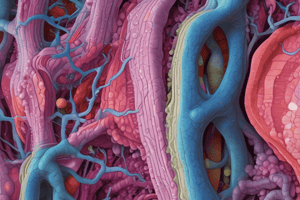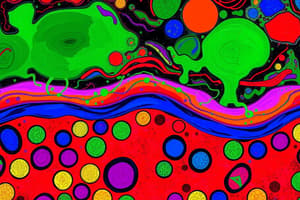Podcast
Questions and Answers
What is the function of the basement membrane in epithelial cells?
What is the function of the basement membrane in epithelial cells?
- To provide structural support to the nucleus
- To act as a semipermeable filter for substances reaching epithelial cells (correct)
- To regulate cell shape
- To synthesize collagen type III
Which molecule cross-links laminin to the collagen network in the basal lamina?
Which molecule cross-links laminin to the collagen network in the basal lamina?
- Nidogen (correct)
- Type IV collagen
- Laminin
- Reticular lamina
What is the role of reticular fibers in the reticular lamina?
What is the role of reticular fibers in the reticular lamina?
- Cross-link laminin to collagen IV
- Provide structural support to epithelial cells
- Act as a semipermeable filter
- Help determine the porosity of the basal lamina (correct)
Which type of junction forms a seal between adjacent epithelial cells?
Which type of junction forms a seal between adjacent epithelial cells?
To which type of collagen is the reticular lamina bound to the basal lamina?
To which type of collagen is the reticular lamina bound to the basal lamina?
What is the main function of junctional complexes in epithelial cells?
What is the main function of junctional complexes in epithelial cells?
What is the main function of connexons in cell communication?
What is the main function of connexons in cell communication?
Which type of junction is responsible for mediating intercellular communication?
Which type of junction is responsible for mediating intercellular communication?
What is the role of integrins in hemidesmosomes?
What is the role of integrins in hemidesmosomes?
Where are microvilli mainly present and what is their main function?
Where are microvilli mainly present and what is their main function?
Which cellular structure has finger-like extensions and contains actin filaments?
Which cellular structure has finger-like extensions and contains actin filaments?
What is the central pore size of connexons that allow intercellular exchange?
What is the central pore size of connexons that allow intercellular exchange?
What type of cells have abundant cilia?
What type of cells have abundant cilia?
Which type of microtubule is composed of 10 tubulin dimers?
Which type of microtubule is composed of 10 tubulin dimers?
Where are stereocilia found in males?
Where are stereocilia found in males?
What is the function of stereocilia in the internal ear?
What is the function of stereocilia in the internal ear?
What anchors the basal body within the cell cytoplasm?
What anchors the basal body within the cell cytoplasm?
Which type of epithelium divides into covering/lining or glandular?
Which type of epithelium divides into covering/lining or glandular?
Where are goblet cells usually seen in epithelia?
Where are goblet cells usually seen in epithelia?
Which type of epithelium appears cuboidal when relaxed and squamous when stretched?
Which type of epithelium appears cuboidal when relaxed and squamous when stretched?
What is the main function of stratified squamous keratinized epithelium?
What is the main function of stratified squamous keratinized epithelium?
Where can stratified cuboidal epithelium be found?
Where can stratified cuboidal epithelium be found?
What is the distinguishing feature of pseudostratified columnar epithelium?
What is the distinguishing feature of pseudostratified columnar epithelium?
Where is simple squamous epithelium found?
Where is simple squamous epithelium found?
Which type of epithelium is classified based on the shape of the most superficial layer?
Which type of epithelium is classified based on the shape of the most superficial layer?
Which type of epithelium is rich with organelles and involved in active transport?
Which type of epithelium is rich with organelles and involved in active transport?
Where are goblet cells found and what do they produce?
Where are goblet cells found and what do they produce?
In which structure are nuclei the thickest and most noticeable?
In which structure are nuclei the thickest and most noticeable?
Flashcards
Basement Membrane Function
Basement Membrane Function
Provides structural support and anchorage for epithelial cells, acting as a selective filter influencing cell behavior and function.
Laminin and Entactin (Nidogen)
Laminin and Entactin (Nidogen)
Laminin cross-links with the collagen network via entactin (nidogen), crucial for basal lamina structure.
Reticular Fibers Role
Reticular Fibers Role
In the reticular lamina, provide structural support and form a scaffold for surrounding cells.
Tight Junctions
Tight Junctions
Signup and view all the flashcards
Type III Collagen
Type III Collagen
Signup and view all the flashcards
Junctional Complexes
Junctional Complexes
Signup and view all the flashcards
Gap Junctions
Gap Junctions
Signup and view all the flashcards
Connexons
Connexons
Signup and view all the flashcards
Intercellular Communication
Intercellular Communication
Signup and view all the flashcards
Integrins (Hemidesmosomes)
Integrins (Hemidesmosomes)
Signup and view all the flashcards
Microvilli Function
Microvilli Function
Signup and view all the flashcards
Microvilli Structure
Microvilli Structure
Signup and view all the flashcards
Connexon Pore Size
Connexon Pore Size
Signup and view all the flashcards
Cilia Location
Cilia Location
Signup and view all the flashcards
Microtubules Composition
Microtubules Composition
Signup and view all the flashcards
Stereocilia (Males)
Stereocilia (Males)
Signup and view all the flashcards
Stereocilia (Ears)
Stereocilia (Ears)
Signup and view all the flashcards
Basal Body Anchoring
Basal Body Anchoring
Signup and view all the flashcards
Epithelium Types
Epithelium Types
Signup and view all the flashcards
Goblet Cell Location
Goblet Cell Location
Signup and view all the flashcards
Transitional Epithelium
Transitional Epithelium
Signup and view all the flashcards
Keratinized Stratified Squamous
Keratinized Stratified Squamous
Signup and view all the flashcards
Study Notes
Basement Membrane Functions
- Provides structural support and anchorage for epithelial cells.
- Acts as a selective filter, influencing cell behavior and function.
Molecules in the Basal Lamina
- Laminin cross-links with the collagen network via a molecule known as entactin (nidogen).
Reticular Fibers Role
- Present in the reticular lamina, these fibers provide structural support and form a scaffold for surrounding cells.
Junctions and Seals
- Tight junctions create a seal between adjacent epithelial cells, preventing leakage of materials.
Collagen Types
- The reticular lamina is primarily bound to type III collagen, providing strength and structure.
Junctional Complexes
- Junctional complexes function to maintain the integrity of epithelial tissue and facilitate adhesion between cells.
connexons in Communication
- Connexons form gap junctions that allow direct intercellular communication through small molecules and ions.
Intercellular Communication Junctions
- Gap junctions mediate intercellular communication, enabling the transfer of signaling molecules.
Integrins in Hemidesmosomes
- Integrins anchor epithelial cells to the basal lamina, reinforcing adherence and stability.
Microvilli Presence and Function
- Microvilli are primarily found in intestinal epithelial cells, enhancing absorption and increasing the surface area.
Cellular Structure Extensions
- Microvilli are finger-like extensions containing actin filaments, playing a crucial role in absorption.
Connexon Pore Size
- The central pore size of connexons is approximately 1.5 nanometers, allowing small molecules to pass between cells.
Cells with Abundant Cilia
- Epithelial cells in the respiratory tract and female reproductive tract typically have abundant cilia for movement and clearance.
Microtubule Composition
- Stable microtubules, composed of 10 tubulin dimers, are essential for supporting cell structure and transport.
Location of Stereocilia in Males
- Stereocilia are found in the epididymis of male reproductive organs, facilitating sperm maturation.
Stereocilia Function
- In the internal ear, stereocilia play a vital role in mechanotransduction, converting sound waves into neural signals.
Basal Body Anchoring
- The basal body is anchored within the cell cytoplasm by proteins and structures that stabilize its position for ciliary movement.
Epithelium Classification
- Epithelium divides into covering/lining or glandular types, based on their function and structure.
Goblet Cells Location
- Goblet cells, which produce mucus, are commonly seen in the respiratory and gastrointestinal tracts.
Transitional Epithelium Behavior
- Transitional epithelium appears cuboidal when relaxed and squamous when stretched, allowing flexibility.
Stratified Squamous Keratinized Epithelium
- This epithelium provides a protective barrier against abrasion and dehydration.
Stratified Cuboidal Epithelium Location
- Found in ducts of sweat glands and salivary glands, providing protection and secretion.
Distinguishing Feature of Pseudostratified Columnar Epithelium
- Characterized by varying cell heights, giving an illusion of multiple layers, typically found in respiratory passages.
Simple Squamous Epithelium Location
- Found lining blood vessels (endothelium) and alveoli, facilitating diffusion and filtration.
Classification Based on Surface Layer Shape
- Epithelium is classified based on the shape of the most superficial layer, impacting its functional capabilities.
Organelles and Active Transport
- Columnar epithelium is rich in organelles and is involved in active transport processes, especially in nutrient absorption.
Goblet Cells Production
- Goblet cells produce mucus, providing lubrication and protection in epithelial tissues.
Notable Structure for Nuclei
- In stratified squamous epithelium, nuclei are the thickest and most noticeable, as they indicate cell layers and differentiate between keratinized and non-keratinized types.
Studying That Suits You
Use AI to generate personalized quizzes and flashcards to suit your learning preferences.



